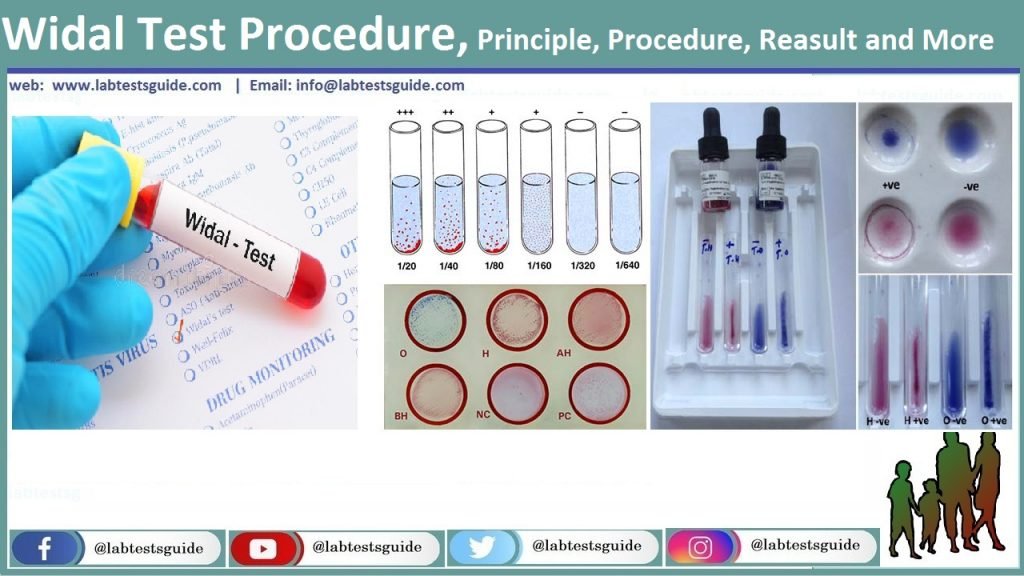Widal test is used for the diagnosis of enteric fever. Enteric fever refers to typhoid and paratyphoid caused by Salmonella typhi and Salmonella paratyphi (A, B, C) respectively. The bacterium is spread due to intake of food or water contaminated with the faeces of an infected person (poor hygienic conditions). Typhoid fever is significant cause of morbidity across the world, with an estimated 12 to 33 million cases occurring annually. Widal test is an easy, cheap, easily accessible and non invasive test to perform. It is of great significance in laboratories where blood cultures facility is not available (the results must be interpreted cautiously, as negative results do not exclude typhoid fever).

Purpose Of The Test (Indication)
- This test is done to diagnose enteric fever (Typhoid and paratyphoid fever).
Pathophysiology
- History of widal test:
- In 1896 widal test was discovered by George-Fernand Widal for the diagnosis of enteric fever.
- Enteric fever includes typhoid and paratyphoid fever.
- Paratyphoid fever is milder than typhoid fever.
- Enteric fever also called as typhoid fever.
- Typhoid fever is caused by the bacterium Salmonella Typhi.
- Salmonella typhi has an incubation period of 14 to 21 days. Sometimes may even longer.
- 30% of the cases become chronic carriers due to persistent infection of the gallbladder.
- The incubation period is 7 to 14 days.
- Typhoid fever is common in the developing world, where it affects about 21.5 million persons each year.
- Salmonella Typhi lives in humans and also found in chickens and eggs.
- It is present in the blood and intestinal tract.
- The carrier can harbor bacilli in the gallbladder.
- Both patients and carriers shed Salmonella Typhi in their feces (stool).
Mode Of Spread
- Food: if food or drinks are contaminated.
- Spread from the carrier, who is shedding Salmonella Typhi.
- Contaminated drinking water: If sewage water is contaminated with Salmonella Typhi.
- Typhoid fever is more common in areas of the world where handwashing is less frequent.
- Once Salmonella Typhi bacteria are eaten or drunk, they multiply and spread into the bloodstream.
Signs And Symptoms:
- The patient has a fever and the pattern of the fever is typical.
- Fever is persistent and does not touch normally. This may be as high as 103 to 104 F.
- The patient may feel weak.
- May have stomach pains, headaches, or loss of appetite.
- In some cases, patients have a rash of flat type and rose-colored spots.
Sample Required:
Clotted or Serum Sample Required
Treatment:
- The drug of choice is chloramphenicol but it has many side-effects.
- Ciprofloxacin is now a drug of choice.
- Ampicillin, amoxicillin, 3rd generation cephalosporins, and fluoroquinolones can be used.
- C0-trimoxazole is better than chloramphenicol with less side-effect.
Carriers:
- It is difficult to treat carriers because of gall bladder involvement.
- Ampicillin is the most useful drugs but it is to be given in larger doses and for a longer period of time.
- Chloramphenicol is less effective than ampicillin.
- Ciprofloxacin can also be tried.
- The ultimate end is cholecystectomy.
For Nonmedical person explanation of Widal test (Enteric fever):
- Please advise the Widal test if the fever persists more than 5 days at least.
- Just see the O antigen titer if it is 1:160, indicate Enteric fever.
- If O antigen is 1:80 then repeat the test after 5 to 7 days and now the titer is 1:160, rising titer again indicates acute infection.
- While H antigen does not indicate acute infection or acute enteric fever.
Related Articles:
RSS Error: https://www.labtestsguide.com/category/tests/feed is invalid XML, likely due to invalid characters. XML error: > required at line 490, column 16
RELATED POSTS
View all

